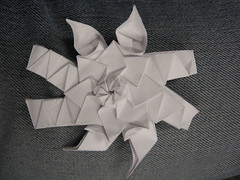I've been thinking a lot about the various visual and technical effects that can be acheived using pleats. As in box-pleating (1) and corrugations (2), we can use them to collapse our paper into different forms, really whatever we want. We can use them in tessellations to store spare paper (3), which we then pull out at later points (4) to create twist-folds, geometric patterns, and all sorts of other things. We can also use it to change the proportions of flaps and models, in the forms of grafts and pleat-sinks.
But pleats have a number of visual effects that make them important as well. We can use pleats to create full, rounded three-dimensional forms and curves (5, 6). We can also use them to add detail that would take up too much paper with points, such as hair (7) and texture (8).
But there are still other uses of pleats, that I would like to see a little more of. I have made a few pleated models, really just simple corrugations that, to my surprise, ended up implying motion (9, 10) and even feeling (11), both subjects that deserve more attention in the origami community.
But all this makes me wonder, what else can pleats do that we haven't thought of yet, or that we haven't explored?
Monday, October 8, 2007
Wednesday, October 3, 2007
Flower Tower Variations

Watch, I'll come up with a good name for this two days after I post it...
Originally uploaded by origami_madness
Anyway, I have recently made twenty-some variations on Chris Palmer's Flower Tower. This is one of them, and you can see the rest on my photostream if you like (http://www.flickr.com/photos/ahudson/).
I started doing these right after I found out about the decreeping technique from a description of the process that Tom Hull had written (www.spundreams.net/~andy/origami/flower-tower-howto.txt). Working from there, I modified the model by pursing the center in different ways, and then generalized the structure to a non-logarithmic form, which you see here in this picture. I also used some elias stretches and shaping folds to finish it off.
Anyway, I'm starting work on a big post about logarithmic tessellations (like this one), and I should post it in the next month or so.
Subscribe to:
Posts (Atom)